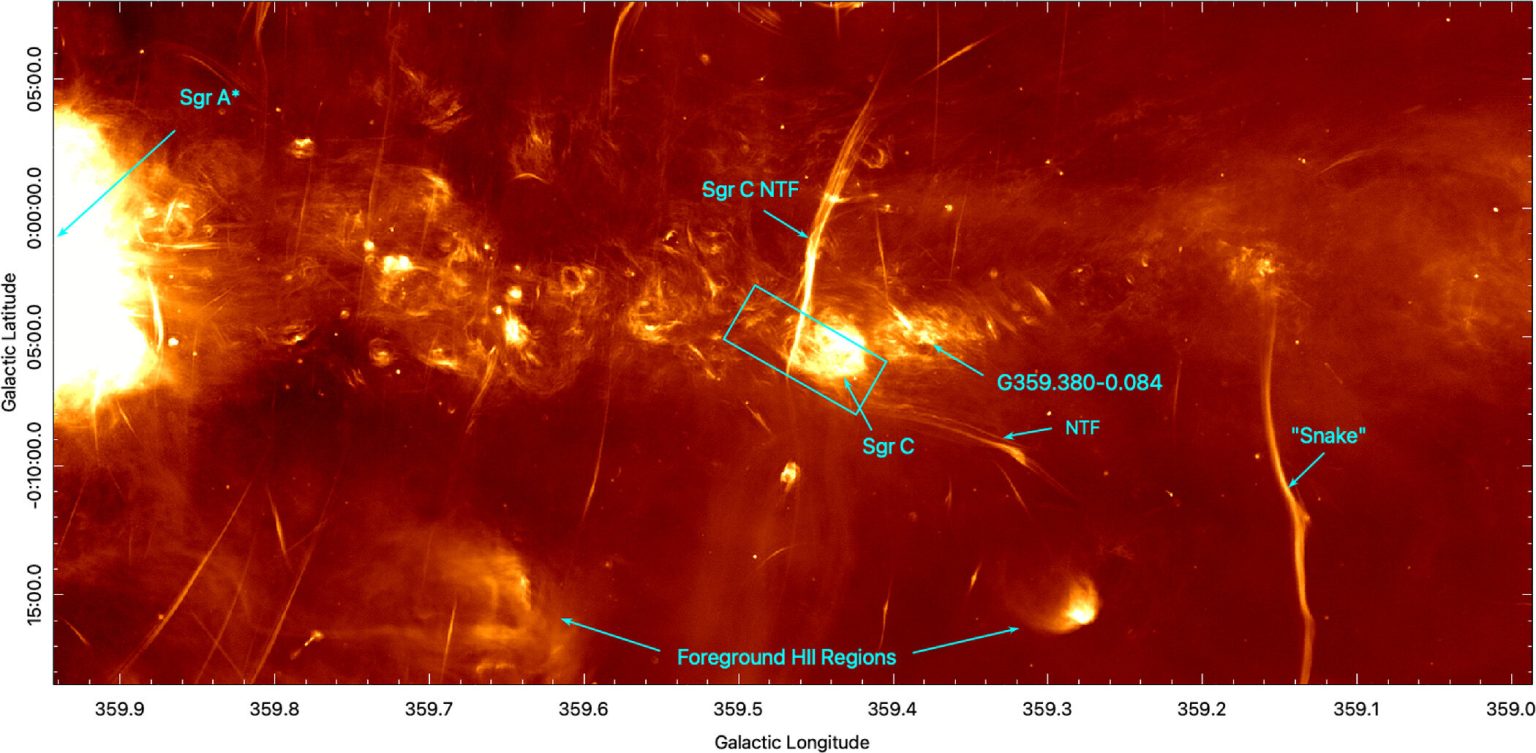The James Webb Space Telescope has investigated the source of the Sagittarius C radio emission. It turned out to be one of the most extreme environments in the Milky Way. Here, only 200 light-years away from the supermassive black hole is a giant gas cloud in which new luminaries are born.

Extreme environment in the Milky Way
Sagittarius C is one of the most extreme environments in the Milky Way galaxy. This cloudy region of space is about 200 light-years away from the supermassive black hole at the center of our galaxy. This massive and dense cloud of interstellar gas and dust collapsed on itself over millions of years to form thousands of new stars.
In a new study, a team of scientists used observations from NASA’s James Webb Space Telescope to study Sagittarius C in unprecedented detail. The study was led by astrophysicist John Bally of the University of Colorado at Boulder, Samuel Crowe of the University of Virginia, Ruben Fedriani of the Andalusian Astronomical Institute in Granada and their colleagues.
The resulting data may help solve a long-standing mystery about the hidden regions of the galaxy, or what scientists call the Central Molecular Zone (CMZ): The density of interstellar gas is high in this region. So why are fewer new stars being born here than scientists have ever expected?
Researchers found that powerful magnetic field lines seem to permeate Sagittarius C, forming long and bright strands of hot hydrogen gas that look a bit like spaghetti noodles – a phenomenon that could slow the rate of star formation in the surrounding gas.
“It’s in a part of the galaxy with the highest density of stars and massive, dense clouds of hydrogen, helium and organic molecules,” said Bally, a professor in the Department of Astrophysical and Planetary Sciences at CU Boulder. “It’s one of the closest regions we know of that has extreme conditions similar to those in the young universe.”
Stellar nursery
The study sheds light on the turbulent birth and death of stars in the Milky Way galaxy.
Stars tend to form in so-called “molecular clouds,” that is, in regions of space containing dense clouds of gas and dust. The closest such stellar nursery to Earth is in the Orion Nebula, just below Orion’s belt. There, the molecular clouds collapsed over millions of years, forming a cluster of new stars.
Such active star formation sites also predict their own demise. When new stars grow, they begin to emit lots of radiation into space. This radiation, in turn, blows away the surrounding cloud, depriving the region of the matter needed to create new stars.
“Even the Sun, we believe, formed in a massive cluster like this one,” Bally says. “Over billions of years, all of our sibling stars have moved away.”
In a separate study published today in the same journal, the authors took a deep dive into the growth of “protostars” forming in Sagittarius. Their data reveal a detailed picture of how these young stars emit radiation and blow gas and dust around them.
Magnetic fields in the zone of Sagittarius C
In his study, Bally investigated the unusual appearance of Sagittarius C. He explained that while the Orion Nebula appears mostly smooth, Sagittarius C is quite different. Dozens of bright filaments are woven into this region, some of which are several light-years long. These filaments are made up of plasma, a hot gas of charged particles.
“We certainly didn’t expect to see these filaments,” said Ruben Fedriani, a co-author of the study and a postdoctoral researcher at the Institute of Astronomy of Andalusia in Spain. “It was a totally unexpected discovery.” Bally noted that the secret of Sagittarius C’s filaments and the nature of its star formation probably comes down to magnetic fields.
The supermassive black hole, which has a mass about four million times that of our Sun, is located at the center of the galaxy. The motion of the gas swirling around this behemoth is able to stretch and amplify the surrounding magnetic fields. These fields, in turn, form the plasma in Sagittarius C.
Bally suspects that the Orion Nebula looks much smoother because it is in a much weaker magnetic environment.
Scientists have long known that the inner regions of the galaxy are important birthplaces for new stars. But some calculations suggest that this region should produce many more young stars than we observe. In CMZs, magnetic forces may be strong enough to resist the gravitational collapse of molecular clouds, limiting the rate of new star formation.
Despite this, the time of Sagittarius C may be coming to the end. The region’s stars have already blown away much of its molecular cloud, and this nursery could disappear completely in a few hundred thousand years.
According to phys.org


